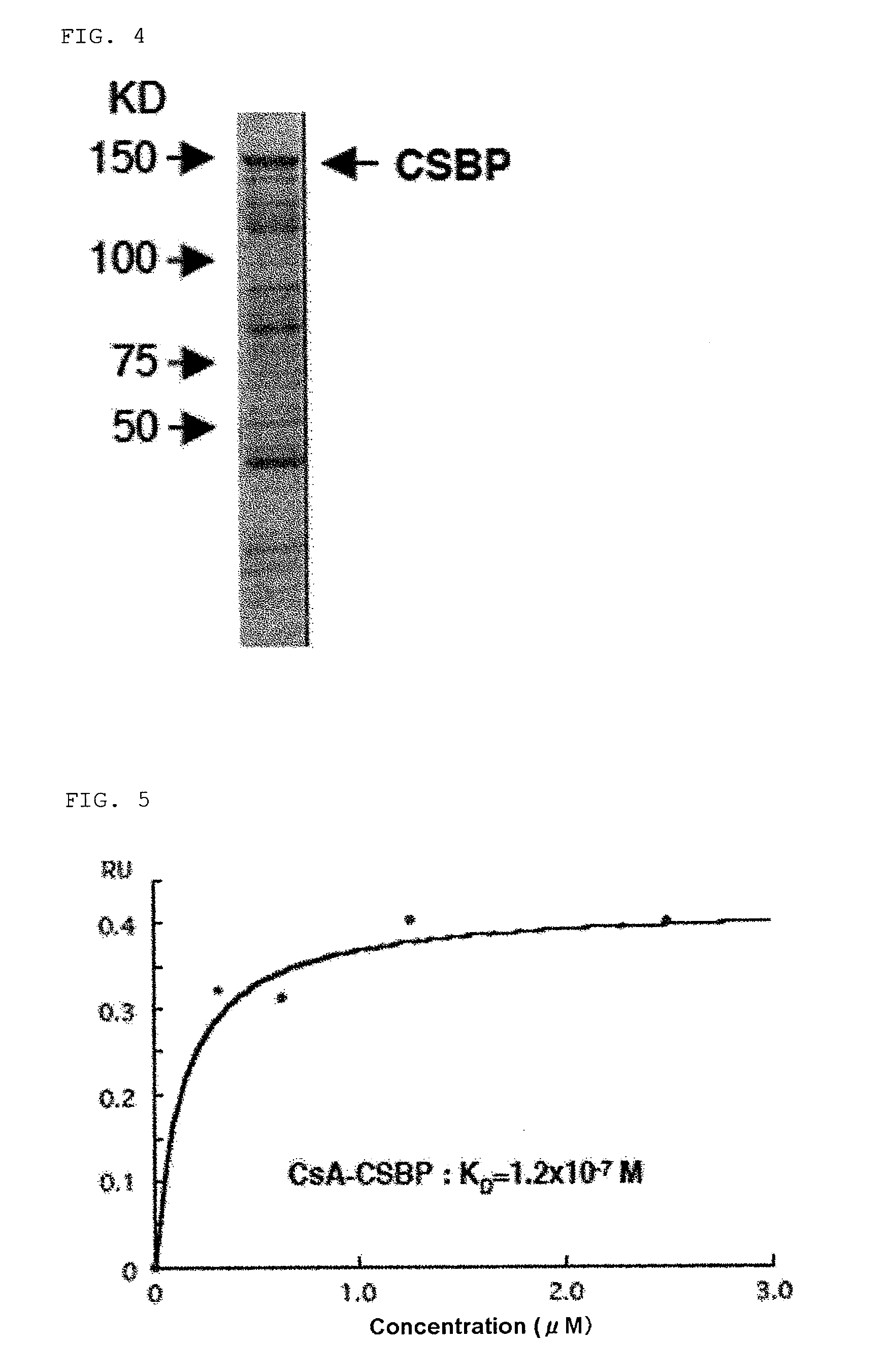Cyclosporin a-binding protein
- Summary
- Abstract
- Description
- Claims
- Application Information
AI Technical Summary
Benefits of technology
Problems solved by technology
Method used
Image
Examples
example 1
Cloning of CSABP
[0183]CsA-binding human intracellular protein was cloned using a phage display method. First, CsA was photochemically covalently bonded to PEG resin beads (CsA beads). 0.5 mg of CsA beads was added to 1×1011 pfu of a random 12-peptide phage library (prepared using T7Select® 10-3 OrientExpress cDNA Cloning System, Oligo (dT) (Novagen)), and incubation was carried out at 4° C. overnight. The beads were washed with 1 mL of 1×TBST (50 mM Tris, pH 8.0, 150 mM NaCl, 0.1% Tween20) a total of 10 times, 100 μL of infectable E. coli was then added thereto, and phage was collected directly from the beads. 0.5 mg of beads were added again to 1×1011 pfu of the phage thus collected, and the series of operations was repeated a total of 4 times. 5 independent phages were amplified individually from the 4th collected phage, about 1×1010 pfu of phage was incubated with 0.5 mg of beads at 4° C. overnight, and 1% SDS was added thereto to lyse the phage. The proportion of the phage lysis...
example 2
Analysis of CSABP Expression
[0185]CSABP expression conditions in various tissues and cell lines were analyzed by a northern blot method and an RT-PCR method.
(1) Northern Blot Analysis
[0186]Northern blotting was carried out based on a standard method. The total RNAs used were from normal human liver tissue (Human Liver Total RNA, Clontech), an SKBR-3 human breast cancer cell line, an Huh-7 human liver cancer cell line, and an MH14 HCV genome replicon cell line, and extraction of total RNA from each cell line was carried out using an RNeasy kit (Invitrogen). 20 μg of an RNA sample was subjected to electrophoresis using a formaldehyde-denatured gel. After the electrophoresis was completed, the gel was transferred to a nylon membrane (Hybond-N+) overnight, crosslinked by UV crosslinking, and dried. Hybridization was carried out by a random primer method (Rediprime II, GE healthcare) using CSABP gene labeled with 32P as a probe (5′-acgaagtgatgggtgggagcgagcc-3′ (SEQ ID No: 3) and 5′-cccat...
example 3
Synthesis of CSABP Recombinant Protein
[0189]CSABP gene was amplified by PCR using a primer with EcoRI and XhoI recognition sequences added (forward primer: 5′-CCGAATTCATGTCCAGGCCGAGCAGCGTCTCC-3′ (SEQ ID No: 7), reverse primer: 5′-CCCTCGAGTCAATCAGTTGTGTTTTTTTCTCCC-3′ (SEQ ID No: 8) (the underlining denotes restriction enzyme recognition sequences)) with a cDNA library of human breast cancer cell line SKBR-3 as a template, and cloned into pET vector (Invitrogen). pET-CSABP-FL and pET-CSABP-C (FL=full length, C=C terminal region (CSABP ORF: 193rd to 1430th amino acids)) were introduced into E. coli (BL21 (DE3)), and cultured in the presence of 0.1 mM IPTG at 20° C. overnight to thus express protein. E. coli that had induced expression of CSABP was recovered, a soluble fraction was purified using HisTrap (Amersham), and following this the purified protein was checked for molecular weight by SDS-PAGE (Coomassie staining) (FIG. 4). A band of the purified protein was observed at a molecula...
PUM
| Property | Measurement | Unit |
|---|---|---|
| Fraction | aaaaa | aaaaa |
Abstract
Description
Claims
Application Information
 Login to View More
Login to View More - R&D
- Intellectual Property
- Life Sciences
- Materials
- Tech Scout
- Unparalleled Data Quality
- Higher Quality Content
- 60% Fewer Hallucinations
Browse by: Latest US Patents, China's latest patents, Technical Efficacy Thesaurus, Application Domain, Technology Topic, Popular Technical Reports.
© 2025 PatSnap. All rights reserved.Legal|Privacy policy|Modern Slavery Act Transparency Statement|Sitemap|About US| Contact US: help@patsnap.com



